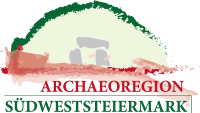During archaeological excavations, a site was discovered in Retznei that dates from the Bronze Age to the Roman period.
Several Celtic buildings beneath the Roman structures, which included two baths, testify to the importance of the site. An altar to the goddess Fortuna Augusta, numerous excavation finds as well as the excavated ground plan of a nymphaeum (a spring sanctuary) provide evidence that the site was originally a Celtic sanctuary, monumentally decorated in the Roman imperial period. The museum in the “Rauchstubenhaus” displays, among other things, elements of the luxurious furnishings of the Roman buildings, but also Celtic bronze jewelry and an altar to the goddess Fortuna.
The village of Retznei is also known as a site of fossils found in the Leithakalk, which is now mined in several quarries. One room in the museum is dedicated to geology and local history, another to archaeological finds, the significance of which is explained on display boards. A film about archaeological discoveries in Retznei as well as other sites and the related problems of protecting archaeological monuments is also shown in the museum. Guided tours to the archaeological site in Retznei (300 m from the museum) as well as to neighboring monuments are offered.
In 2014, a small museum – or rather a showroom – was opened in Retznei, dedicated to the archaeological site there.
Fri. 9 a.m. – 5 p.m. and Sat. 9 a.m. – 1 p.m.
For groups by appointment also outside regular opening hours.
Contact:
Retznei 26, A-8461 Ehrenhausen an der Weinstraße
T: +43 699 1276 0724, office@asist.at
www.asist.at
The name of the museum may be misleading, since the question of whether the imperial-era complex was actually a villa has not yet been resolved. The first excavations took place in 1873, when Prof. Friedrich Pichler made sondages for the Joanneum regional museum. The work was stopped after a few weeks, but soon a report appeared in the periodical “Mittheilungen der k. k. Central-Commission für Erforschung und Erhaltung der Kunst- und historischen Baudenkmale.” The excavations were continued only in 2004, when questions arose about the localization of the old excavation and about the character and periodization of the villa. In the following years the association ASIST (Archaeological-Social Initiative Styria), founded in 2006, carried out investigations, collaborating with venture with ST:WUK (Steirische Wissenschafts-, Umwelt- und KulturprojektträgergesmbH.).
Initially, the imperial-era site, rudimentarily described by Friedrich Pichler, was uncovered and an attempt was made to clarify chronology, construction phases and functions of the buildings, but over time questions about the preceding prehistoric phases also came into view. A smaller Middle Bronze Age settlement was located on the site where a larger complex, which we currently address as a group of farmsteads, was built in the late Middle La Tène period. The La Tène period finds came to light in a large area. Due to the construction work during the imperial period, but also due to later interventions and disturbances, it has not yet been possible to clarify the structure of the settlement in question in more detail, but our work is ongoing.
Several pit huts were located beneath the Roman building; post buildings as well as other features that cannot be clearly interpreted were documented and should be evaluated soon. The associated finds belong to the phases La Tène C2 as well as to the following Late La Tène period. The attempt of a more exact chronological classification of the ceramic finds is still in progress. In any case, finds from the Early Augustan period suggest the possibility of continuous use into the Early Imperial period, which undoubtedly makes the site an important research object for the question of breaks or continuities between the Late La Tène period and the Roman Imperial period.
The first stone building, soon followed by alterations and additions, was erected in the Flavian period. A large bath complex was erected in the middle of the 2nd century A.D., another large building, also a bath complex, in the 3rd century A.D. The function of the individual rooms within the bathing complex can largely be deduced, but it is not easy to clarify a tract in the southeast, which could have been a nymphaeum.
It is remarkable that until now residential wings or outbuildings could not be localized. Whether this can be explained by the restriction of the excavation area to a small space or whether the Roman complex had another semi-public(?) function which we cannot name yet, has to be asked.
There are several scientific questions to be investigated, but after many years of field archaeological work, the perspective of a museum presentation was also important. An old listed farmhouse in the village of Retznei, 200 m from the site, was renovated for this purpose and has since been opened under the name “Museum Villa Retznei.” Finds from recent years of excavation are displayed there, as well as a central find from Friedrich Pichler’s early work, an altar to the goddess Fortuna, a loan piece from the Landesmuseum Joanneum. The village of Retznei is also known as a site of fossils found in the Leithakalk, which is now mined in several quarries. One room is dedicated to geology and local history, another to archaeological findings, the significance of which is explained on display boards. A film about archaeological discovery of the villa as well as other sites and the related problems of protection of ground monuments is also shown. Guided tours to the archaeological site as well as to neighboring monuments are offered.
Text: Mag. Dr. Bernhard Schrettle

